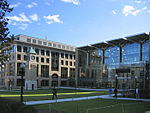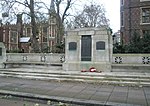Stone Buildings

Stone Buildings, Lincoln's Inn were constructed from 1774 to 1780. The architect was Sir Robert Taylor. Stone Buildings is a Grade I listed building. Stone Buildings appear in Anthony Trollope's novel The Prime Minister.Stone Buildings are so-called from the material with which they are constructed. They were constructed in accordance with an ultimately unrealised plan to rebuild Lincoln's Inn entirely in stone. Their construction was the initial step in that plan.The working drawings were made by a young man called Leach, then a clerk in Taylor's office, who later became Master of the Rolls. Leach's drawings are preserved in the Library of Lincoln's Inn. Pitt's chambers appear to have been in Stone Buildings from December 1779. Canning's father was "for some time with a Serjeant Walker who then resided in Stone Buildings". The South end was added from 1844 to 1845 under the direction of Philip Hardwick.Stone Buildings are situated parallel with the west side of Chancery Lane, and the western range of buildings faces the gardens of Lincoln's Inn and the square, with an oblong court between the two buildings. The Chancery Lane side is very plain, but the garden front consists of a rustic basement, with arcades and windows, at the north end of which is a wing consisting of six Corinthian pillars, which support an entablature and pediment. The cornice of the wing is continued through the whole length of the front, which terminates in a balustrade, but the two ranges of windows are entirely plain. The northern entrance is by handsome iron gates in Chancery Lane. The structure is not in keeping with the architecture of the other buildings; but, when viewed through the foliage of the garden, it has a very pleasing effect.On 23 December 1790, by the violence of the wind at noon, the copper covering of the roof of the new buildings was blown off in one sheet, and hung over the front like a large carpet or mainsail. The noise occasioned by this accident made the neighbourhood conclude the building was falling down. Some of the plates composing this covering were torn off and carried into a yard in Holborn.Sir Charles Wetherell had chambers in Stone Buildings. The Duke of Wellington took shelter there when he was attacked by a mob on 18 June 1832.The Registers' and Accountant-General's Offices were at 8, 9 and 11 Stone Buildings.The buildings are faced with Portland stone.The buildings that comprise Stone Buildings are numbered from 1 to 11. 1 and 11 Stone Buildings are opposite separate sides of 76B Chancery Lane. 7 and 8 Stone Buildings are opposite 10 to 12 Old Square.
Excerpt from the Wikipedia article Stone Buildings (License: CC BY-SA 3.0, Authors, Images).Stone Buildings
Serle Street, London Holborn (London Borough of Camden)
Geographical coordinates (GPS) Address Website Nearby Places Show on map
Geographical coordinates (GPS)
| Latitude | Longitude |
|---|---|
| N 51.5175 ° | E -0.1141 ° |
Address
Lincoln's Inn
Serle Street
WC2A 3QP London, Holborn (London Borough of Camden)
England, United Kingdom
Open on Google Maps








